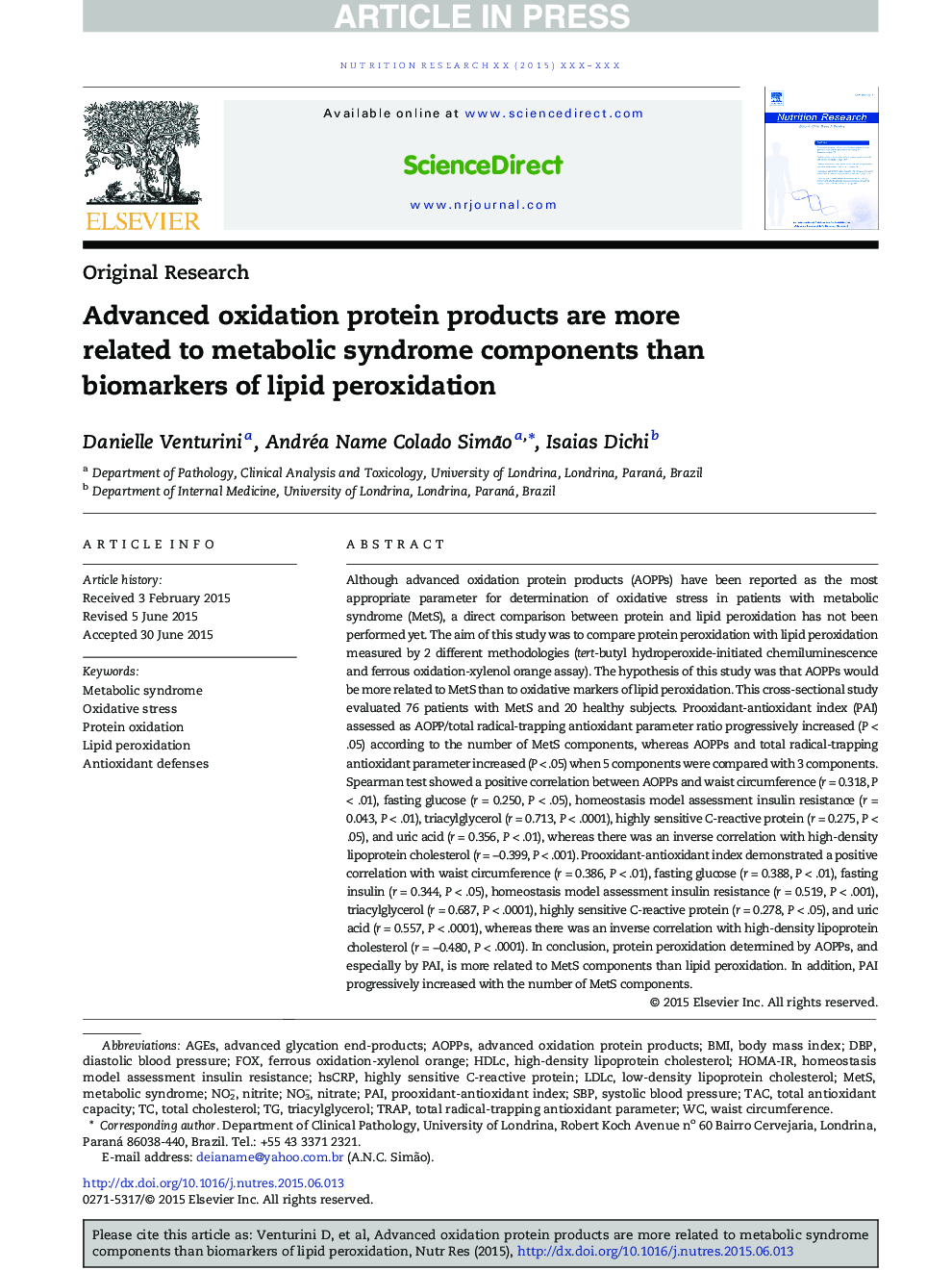| کد مقاله | کد نشریه | سال انتشار | مقاله انگلیسی | نسخه تمام متن |
|---|---|---|---|---|
| 5904418 | 1157997 | 2015 | 7 صفحه PDF | دانلود رایگان |
عنوان انگلیسی مقاله ISI
Advanced oxidation protein products are more related to metabolic syndrome components than biomarkers of lipid peroxidation
ترجمه فارسی عنوان
محصولات پروتئین پیشرفته اکسیداسیون بیشتر به اجزای سندرم متابولیک نسبت به بیومارکرهای پراکسیداسیون لیپید مرتبط هستند
دانلود مقاله + سفارش ترجمه
دانلود مقاله ISI انگلیسی
رایگان برای ایرانیان
کلمات کلیدی
HOMA-IRTotal radical-trapping antioxidant parameterHighly Sensitive C-Reactive ProteinFOXLDLchsCRPHDLCTRAPAGEsTACDBPSBPAOPPs - AOPP هاNO2− - NO2-NO3− - NO3-Protein oxidation - اکسیداسیون پروتئینPAI - باباtriacylglycerol - تری آسیل گلیسرول Oxidative stress - تنش اکسیداتیوAntioxidant defenses - دفاع از آنتیاکسیدانWaist circumference - دور کمرMetabolic syndrome - سندرم متابولیکbody mass index - شاخص توده بدنBMI - شاخص توده بدنیTotal antioxidant capacity - ظرفیت آنتی اکسیدانی کلdiastolic blood pressure - فشار خون دیاستولیکsystolic blood pressure - فشار خون سیستولیکhigh-density lipoprotein cholesterol - لیپوپروتئین پرچگالی یا اچدیالMETS - متسadvanced glycation end-products - محصولات نهایی گلیسایی پیشرفتهadvanced oxidation protein products - محصولات پیشرفته اکسیداسیون پروتئینNitrate - نیتراتNitrite - نیتریتLipid peroxidation - پراکسیداسیون لیپیدtotal cholesterol - کلسترول تامLow-density lipoprotein cholesterol - کلسترول لیپوپروتئین با چگالی کم
موضوعات مرتبط
علوم زیستی و بیوفناوری
بیوشیمی، ژنتیک و زیست شناسی مولکولی
علوم غدد
چکیده انگلیسی
Although advanced oxidation protein products (AOPPs) have been reported as the most appropriate parameter for determination of oxidative stress in patients with metabolic syndrome (MetS), a direct comparison between protein and lipid peroxidation has not been performed yet. The aim of this study was to compare protein peroxidation with lipid peroxidation measured by 2 different methodologies (tert-butyl hydroperoxide-initiated chemiluminescence and ferrous oxidation-xylenol orange assay). The hypothesis of this study was that AOPPs would be more related to MetS than to oxidative markers of lipid peroxidation. This cross-sectional study evaluated 76 patients with MetS and 20 healthy subjects. Prooxidant-antioxidant index (PAI) assessed as AOPP/total radical-trapping antioxidant parameter ratio progressively increased (P < .05) according to the number of MetS components, whereas AOPPs and total radical-trapping antioxidant parameter increased (P < .05) when 5 components were compared with 3 components. Spearman test showed a positive correlation between AOPPs and waist circumference (r = 0.318, P < .01), fasting glucose (r = 0.250, P < .05), homeostasis model assessment insulin resistance (r = 0.043, P < .01), triacylglycerol (r = 0.713, P < .0001), highly sensitive C-reactive protein (r = 0.275, P < .05), and uric acid (r = 0.356, P < .01), whereas there was an inverse correlation with high-density lipoprotein cholesterol (r = â0.399, P < .001). Prooxidant-antioxidant index demonstrated a positive correlation with waist circumference (r = 0.386, P < .01), fasting glucose (r = 0.388, P < .01), fasting insulin (r = 0.344, P < .05), homeostasis model assessment insulin resistance (r = 0.519, P < .001), triacylglycerol (r = 0.687, P < .0001), highly sensitive C-reactive protein (r = 0.278, P < .05), and uric acid (r = 0.557, P < .0001), whereas there was an inverse correlation with high-density lipoprotein cholesterol (r = â0.480, P < .0001). In conclusion, protein peroxidation determined by AOPPs, and especially by PAI, is more related to MetS components than lipid peroxidation. In addition, PAI progressively increased with the number of MetS components.
ناشر
Database: Elsevier - ScienceDirect (ساینس دایرکت)
Journal: Nutrition Research - Volume 35, Issue 9, September 2015, Pages 759-765
Journal: Nutrition Research - Volume 35, Issue 9, September 2015, Pages 759-765
نویسندگان
Danielle Venturini, Andréa Name Colado Simão, Isaias Dichi,
